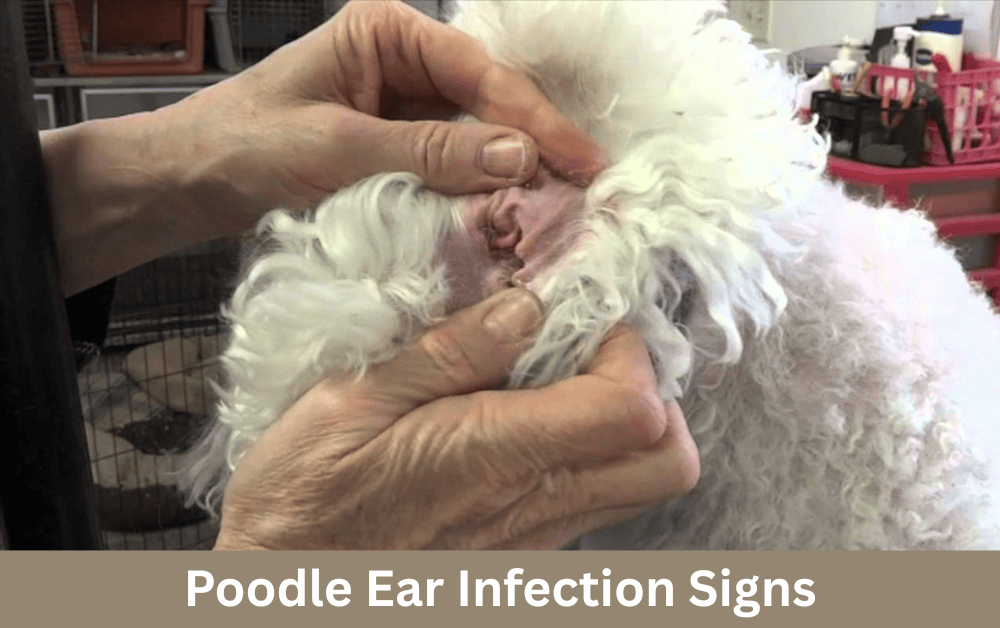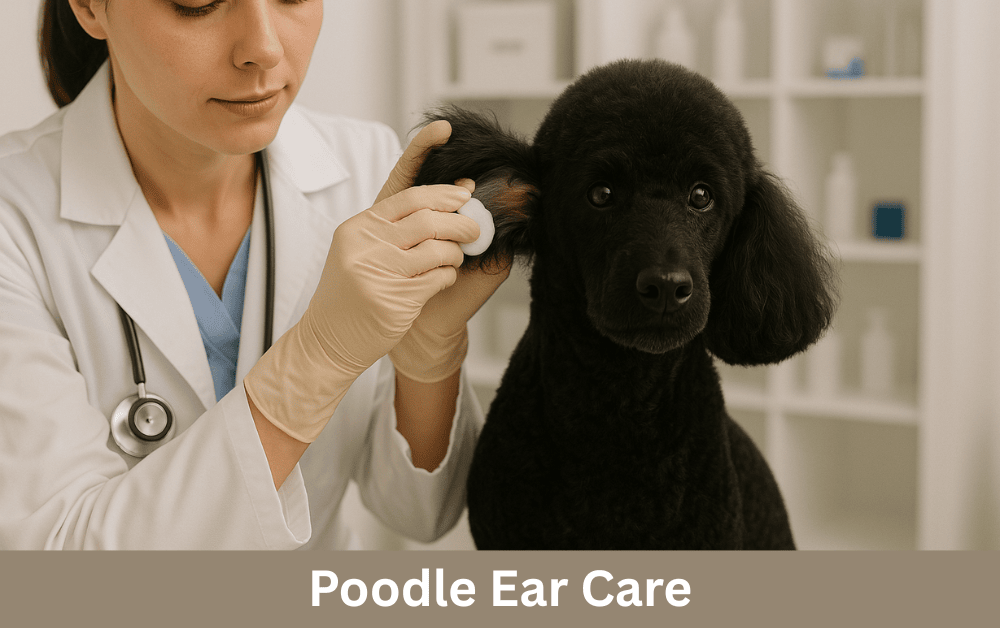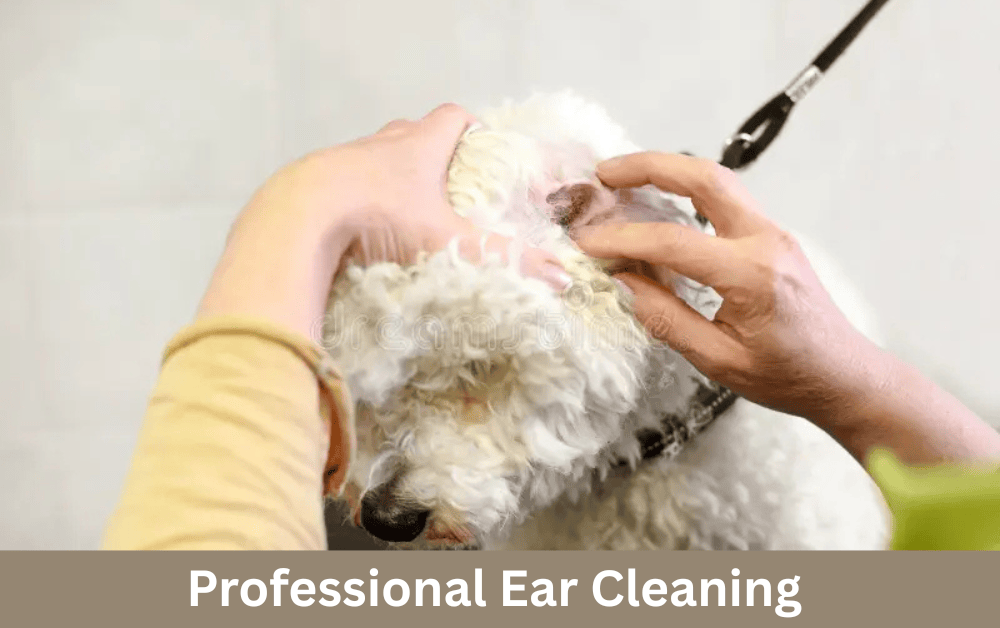- Use a vet-approved ear cleaner like Zymox or Virbac Epi-Otic.
- Gently lift the ear flap and squeeze the cleaner into the ear canal.
- Massage the base of the ear for 20–30 seconds.
- Let your poodle shake its head to bring wax and dirt to the surface.
- Wipe the ear gently with a soft cotton ball or pad.
- Dry the ears well after baths or swimming to stop moisture buildup.
- Check the ears weekly for signs of redness, smell, or discharge.
Avoid using Q-tips, alcohol, or hydrogen peroxide, as they can hurt your dog’s ears. If you clean the ears regularly and keep them dry, you can prevent most infections before they start.
Introduction
Poodle ear cleaning is essential to keep poodles healthy and free from infections. Their floppy ears look cute, but they can trap moisture and dirt. According to the American Kennel Club (AKC), poodles are more prone to ear infections than many other breeds due to their floppy, hair-filled ears. If you don’t clean their ears often, bacteria and yeast can grow inside. That causes itching, pain, and even hearing problems. Good ear care helps your poodle feel better and stay active. You don’t need to be a vet to do it—just follow the right steps. In this guide, you’ll learn how to clean your poodle’s ears the right way and stop infections before they start.
Understanding Poodle Ear Anatomy
Poodles have long, floppy ears that hang down and cover the ear canal. This design blocks airflow and traps moisture inside. Warm, damp spaces help bacteria and yeast grow fast, which leads to infections. On top of that, miniature poodles grow hair inside their ear canals. That extra hair collects dirt, wax, and debris. If you don’t clean it out, the buildup can block the ear and cause more problems. All these factors make ear care very important for poodles. By understanding their ear shape and hair growth, you can take better steps to keep your poodle’s ears clean and infection-free.
Poodle Ear Cleaning Quick Facts Table
| Category | Details |
|---|---|
| How Often to Clean Ears | Every 1–2 weeks for most poodles |
| Warning Signs of Infection | Redness, swelling, odor, discharge, scratching, head shaking |
| Best Cleaning Solution | Vet-recommended ear cleaner (e.g., Virbac Epi-Otic, Zymox Otic) |
| Tools Needed | Cotton pads/balls, vet ear cleaner, towel, grooming gloves (optional) |
| Avoid | Q-tips (can damage the ear canal), alcohol, and hydrogen peroxide |
| Ideal Time to Clean Ears | After a bath or during the regular grooming session |
| Vet Check Frequency | Every 6–12 months or if symptoms appear |
Signs and Symptoms of Poodle Ear Infection

Ear infections in standard poodles can start small but get worse fast if you don’t catch them early. Since their ears trap moisture and debris easily, infections grow quickly. Learning the signs helps you take action before things get serious. Watch your friend closely after a poodle bath, swimming, or allergy flare-ups. If something feels off, check their ears right away. Early Poodle care at home keeps your dog comfortable and prevents bigger problems. According to the American Kennel Club (AKC), a poodle’s ears should be pale pink, clean, and odor-free. Always check them during grooming.”
Signs of Poodle Ear Infections
• Redness and swelling
• Unpleasant odor
• Discharge or buildup
• Frequent scratching or head shaking
• Sensitivity or pain when touching the ears
Causes of Ear Infections in Poodles
Toy Poodles often deal with ear infections more than other dogs. Their unique ear shape and other health factors make their ears a common spot for problems. If you understand what causes these infections, you can stop them before they start. Let’s look at the main causes and how they affect your poodle.
Accumulation of wax and debris
Poodles naturally produce earwax. If you don’t clean it out often, it builds up with dirt and debris. This creates a sticky mess that blocks airflow and gives bacteria and yeast a place to grow. Regular cleaning helps prevent this buildup and keeps the ear canal clear.
Moisture retention
Poodle ears trap water after baths or swimming. Their floppy ears don’t let the moisture dry out fast. This damp space becomes a perfect home for bacteria and yeast. If you don’t dry the ears well, it can lead to painful infections that need treatment.
Allergies and their effect on ear health
Food or environmental allergies can affect your poodle’s ears. Allergies cause redness, swelling, and extra wax. Your dog might shake their head or scratch often. Over time, constant irritation weakens the ear’s defenses and makes infections more likely.
Parasites such as ear mites
Ear mites are tiny insects that live deep in the ears. They feed on wax and skin oils, causing itching and dark, crumbly discharge. If left untreated, mites damage the ear canal and lead to infections. A vet can diagnose and treat mites quickly.
How to Clean Poodle Ears? Step-by-Step Guide

Cleaning your poodle’s ears helps prevent infections and keeps them healthy. You don’t need special skills—just follow the right steps. Doing this regularly removes wax, dirt, and moisture that can lead to problems. Always stay gentle and calm during the process so your poodle feels safe and relaxed.
1. Preparation
Start by gathering everything you need. Get a vet-approved ear cleaner, cotton balls, and a clean towel. Choose a quiet place where your poodle feels comfortable. A calm environment helps your dog stay still and makes the cleaning easier for both of you.
2. Cleaning Process
Gently lift your poodle’s ear flap so you can look inside. Use only a vet-approved ear cleaner and stay calm throughout the process. Never insert anything deep into the ear.
Follow these steps:
- Lift the ear flap gently and hold it up.
- Squeeze a small amount of ear-cleaning solution into the ear canal.
- Massage the base of the ear for 20–30 seconds to loosen wax and debris.
- Let your poodle shake its head—this helps bring debris to the surface.
- Use a soft cotton ball to wipe away dirt and extra cleaner.
- Repeat on the other ear if needed.
3. Post-Cleaning Care
After cleaning, give your poodle a treat and lots of praise. This helps create a positive routine so your dog doesn’t fear ear cleanings. Keep an eye on the ears for a day or two. If you see redness, swelling, or signs of pain, contact your vet.
Frequency of Poodle Ear Cleaning
The frequency of Poodle ear cleaning depends on their activity level and environment. If your poodle is active, loves swimming, or spends time outdoors, their ears may need cleaning once a week. This helps remove dirt, moisture, and excess wax that could lead to infections. For indoor poodles with lower activity levels, cleaning every two weeks is usually enough. However, it’s important not to over-clean your poodle’s ears. Cleaning too often can irritate the ear canal and strip away natural oils that help protect against infections. Balance is key for healthy ears.
Frequency of Ear Cleaning Recommendations:
- Weekly for active, swimming, or outdoor poodles.
- Every two weeks for indoor, less active poodles.
- Avoid over-cleaning to prevent irritation and dryness.
Grooming and Veterinary Care for Poodle Ear Infection

Regular grooming and veterinary care are essential to maintain your poodle’s health and appearance. Knowing when to seek professional grooming or veterinary attention is key to preventing health issues and ensuring your dog stays comfortable.
When to Seek Professional Grooming Services
Professional grooming is important for the poodle coat care, skin, and ears to be in top condition. If you notice any of the following, it’s time to book a grooming appointment:
- Matted or tangled fur: Poodles’ curly coats can easily tangle or mat if not brushed regularly. A professional groomer will remove the mats safely and effectively.
- Overgrown nails: Poodles may have difficulty with nail trimming at home. If nails get too long, they can cause pain or even injury. A groomer can handle this task.
- Ear hair removal: Poodles may have excess hair inside their ears, which traps moisture and dirt. A professional groomer can safely remove this hair, preventing ear infections.
- Regular haircuts: Poodles need consistent haircuts to prevent matting and maintain a neat appearance. A groomer can provide the right trim, whether you want a “puppy cut” or “lion cut.”
Situations That Require Veterinary Attention
Some situations go beyond regular grooming and require immediate veterinary care. Watch for these signs and contact a vet if they occur:
- Persistent ear infections: If your poodle’s ears remain red, swollen, or have a foul odor despite cleaning, it may be an ongoing infection. A vet can prescribe antibiotics or other treatments.
- Severe ear discomfort: If your poodle is constantly scratching their ears, shaking their head, or crying when you touch their ears, it could indicate an infection, mites, or injury.
- Abnormal discharge: Thick, dark, or foul-smelling discharge from the ears can signal an infection that requires medical attention.
- Skin issues around the ears: Redness, swelling, or sores around the ears may indicate an allergic reaction, infection, or parasites, which need a vet’s care.
- Behavioral changes: If your poodle is unusually tired, irritable, or shows signs of distress, it could be due to ear problems or other health concerns that need to be diagnosed by a vet.
Owner Experience:
One of our poodle owners shared his experience of an ear infection. “Last summer, I noticed my poodle, Bella, kept scratching her ears and shaking her head a lot. I thought it was just a little itch, but then I saw a bad smell coming from her ears. I took her to the groomer first, and they told me to see a vet right away. The vet said Bella had an ear infection. She gave us medicine, and I cleaned Bella’s ears every day. After a week, Bella felt much better. Now, I take her to the groomer every month and check her ears often. I learned that ear problems can start small but get bad fast. Taking care of them early really helps”.
By seeking professional grooming and veterinary care at the right time, you help ensure your poodle remains happy, healthy, and comfortable.
Preventative Measures for Healthy Poodle Ears
Preventing ear infections in poodles involves consistent care and attention. By following a few simple steps, you can avoid common ear problems and keep your poodle comfortable. Here’s a breakdown of the key preventative measures you should follow:
1. Regular Ear Inspections (At Least Once a Week)
Regularly inspecting your poodle’s ears is essential. Make sure you check their ears for any signs of redness, swelling, or discharge. Also, watch for any foul odors or excessive wax buildup. If you notice any of these symptoms, act quickly to clean the ears or seek veterinary care. Regular checks help you catch problems early before they turn into infections.
2. Keep Ears Dry, Especially After Baths or Swimming
Moisture in the ears is one of the leading causes of infections in poodles. After every bath or swim, make sure to thoroughly dry your poodle’s ears. Use a soft towel or cloth to wipe out any excess water in the ear canal and the ear flap. Drying the ears reduces the risk of bacterial or yeast growth, which thrives in damp environments.
3. Managing Allergies Effectively
Allergies can cause inflammation in the ears, making them more susceptible to infections. Poodles often suffer from food or environmental allergies. Work with your vet to find the right treatment plan, which may include allergy medications or a special diet. Keeping allergies under control will prevent the ear irritation that often leads to infections.
4. Proper Diet to Support Overall Health
A healthy, balanced diet supports your poodle’s overall health, including their ears. Feed your poodle high-quality food with essential nutrients like omega-3 fatty acids and antioxidants. These nutrients help strengthen their immune system, making it easier for your dog to fight off infections, including ear issues. Consider discussing dietary supplements with your vet if your poodle is prone to ear infections.
Poodle Ear Infection Preventative Measures:
- Regular ear inspections: Check ears weekly for signs of irritation or infection.
- Dry ears thoroughly after baths, swimming, or walks: Moisture leads to bacterial or yeast growth.
- Control allergies with vet-approved medications or a special diet.
- Feed a balanced diet with omega-3 fatty acids and antioxidants to boost overall health and immunity.
By consistently following these steps, you can prevent ear infections and keep your poodle’s ears healthy and clean
Mistakes to Avoid When Cleaning Poodle Ears
Cleaning your poodle’s ears helps prevent infections, but doing it the wrong way can cause more harm than good. Many owners make simple mistakes that lead to irritation or even serious health problems. Let’s look at the most common ones and how to avoid them.
Using Inappropriate Cleaning Solutions
Never use hydrogen peroxide, alcohol, or homemade mixes in your poodle’s ears. These harsh solutions can dry out or burn the sensitive skin inside the ear canal. Always use a vet-approved ear cleaner that’s made for dogs. Ask your veterinarian for a safe brand, especially if your poodle has a history of ear problems.
Inserting Cotton Swabs Deep Into the Ear Canal
Cotton swabs (Q-tips) are a major mistake. Inserting them into the ear canal can push wax and debris deeper or even damage the eardrum. Instead, use a soft cotton ball or pad to wipe the outer ear gently. Let the cleaning solution loosen debris, and let your poodle shake it out naturally.
Ignoring Early Signs of Infection
Many owners overlook the early symptoms of an ear infection. Don’t ignore signs like redness, bad odor, frequent scratching, or head shaking. Catching these signs early allows for quick treatment and prevents the infection from getting worse. If you see these symptoms, call your vet immediately.
Key Mistakes to Avoid:
- Never use alcohol or hydrogen peroxide – They burn and dry out the ear.
- Avoid Q-tips – They push debris deeper and can cause injury.
- Watch for early signs – Redness, smell, or discharge means it’s time to act fast.
Recommended Products for Poodle Ear Care
Using the right products makes ear cleaning safe and effective. Choosing vet-approved solutions and tools helps prevent infections, irritation, and damage. Here’s a list of products you can trust for regular ear care.
Vet-Approved Ear Cleaning Solutions
Look for cleaners made specifically for dogs. These solutions break down wax and remove debris without causing dryness or irritation.
Zymox Ear Cleanser:
Great for weekly use. It contains enzymes that fight bacteria and yeast. Zymox works well for poodles prone to frequent infections.
⭐ Price: Around $12–15
📌 Why it’s good: Non-toxic, soothing, and vet-recommended.
Virbac Epi-Otic Advanced Ear Cleaner:
This cleaner removes wax and dries the canal gently. It’s ideal after swimming or bathing.
⭐ Price: $10–14
📌 Why it’s good: Alcohol-free, low pH formula, safe for long-term use.
Vet’s Best Ear Relief Wash:
Made with natural ingredients like aloe vera and tea tree oil. Great for mild irritations.
⭐ Price: $8–12
📌 Why it’s good: Gentle, soothing, and affordable.
Tools That Help With Safe Cleaning
- Cotton Balls or Rounds: Use soft, plain cotton balls to wipe the outer ear. They absorb cleaner and debris without causing damage.
- Ear Wipes for Dogs: Pre-moistened wipes make cleaning easy and mess-free. Ideal for quick wipe-downs in between deep cleanings.
Example: Pet MD Dog Ear Cleaner Wipes (about $13 for 100 pads) - Towel:
Always keep a clean towel nearby to dry your poodle’s ears after cleaning or bathing. - Treats: Reward your poodle after every cleaning. It builds positive habits and reduces stress next time.
Conclusion
Ear care is not just a grooming step—it’s an important part of your poodle’s health. Regular maintenance helps prevent painful infections and keeps your dog happy and comfortable. You should check your poodle’s ears at least once a week. Clean them using a vet-approved solution, especially after baths or outdoor play. Dry ears properly and always look out for signs like redness, odor, or discharge. Proactive care makes a big difference. By taking just 10 minutes a week, you can avoid expensive vet visits and long treatments. Staying alert and consistent will help your poodle stay healthy and infection-free.
Frequently Asked Questions (FAQs)
Should I pluck the hair inside my poodle’s ears?
Plucking ear hair was common in the past, but now many vets warn that it can irritate the ear canal and cause infections. Others believe it helps improve airflow and keeps the ears dry. If your poodle has sensitive ears or a history of infections, ask your vet before deciding to pluck the hair.
How to Stop Poodle Ear Matting
Brush behind ears daily with a slicker brush – this prevents 90% of mats. Trim ear hair every 3 weeks to 1-inch length. Use detangling spray before grooming. After baths, dry ears completely (damp fur mats 3x faster). For existing mats, work conditioner into the knot and gently comb outward. Never pull – snip vertically if needed.
Do Poodles need ear plucking?
Yes, most poodles need ear plucking because hair grows inside their ears. This hair can trap dirt and moisture, leading to infections. Plucking helps keep the ears clean and dry. Check your poodle’s ears weekly and ask a vet or groomer if you’re not sure.
Is ear plucking painful for dogs?
No, ear plucking can feel uncomfortable, but it shouldn’t be very painful if done gently and correctly. Some dogs don’t mind it, while others may feel a little sting. Using ear powder helps reduce the discomfort. If your dog seems very stressed or in pain, stop and ask a groomer or vet for help.
Can I use homemade ear-cleaning solutions?
No, you should avoid homemade ear cleaners without proper guide. Ingredients like vinegar, hydrogen peroxide, or alcohol are often too harsh. They can dry out or even burn the sensitive tissue inside your poodle’s ears. Stick to vet-approved solutions made for dogs to keep your poodle safe.
What’s the best ear cleaner for poodles with sensitive skin?
For sensitive skin, you should use alcohol-free, vet-approved ear cleaners that contain soothing ingredients like aloe vera or chamomile. Hypoallergenic formulas work best. One of the top choices for sensitive poodles is Vet’s Best Ear Relief Wash, which uses natural ingredients and is gentle on the ears.
How do I calm my poodle before cleaning their ears?
To calm your poodle, use treats to create a positive experience. Calming sprays made from pheromones can also help. Start with short sessions and talk gently to your dog during the process. With consistency and patience, your poodle will feel less stressed over time.
Is a foul smell from my poodle’s ears always a sign of infection?
Not always, but it’s often a warning sign. A mild smell may come from normal wax or dirt, but a strong, yeasty, or fishy odor usually means an infection. If your poodle’s ears smell bad and you also notice discharge or redness, take them to the vet.
Can ear infections cause behavior changes in poodles?
Yes. Ear infections are painful and can cause mood changes. Your poodle may act irritated, anxious, or more withdrawn than usual. In serious cases, you might see head tilting, frequent shaking, or balance problems. These are signs that need immediate vet care.
Can diet affect my poodle’s ear health?
Yes, diet plays a big role in ear health. Food allergies are a common reason for ongoing ear infections in poodles. If your dog gets frequent infections, your vet might suggest switching to a hypoallergenic or limited-ingredient diet to reduce inflammation and allergic reactions.
Are floppy-eared poodles more prone to infections than toy or miniature poodles?
Floppy ears tend to trap more moisture, which creates a warm and damp space where bacteria and yeast grow easily. This makes infections more likely. Still, toy, miniature, and standard poodles all need the same level of ear care to stay healthy, no matter their ear shape.
Can I use baby wipes to clean the outside of my poodle’s ears?
Yes, but only use fragrance-free, hypoallergenic baby wipes to clean the outer ear flap. Never put wipes inside the ear canal. For deeper cleaning, always use cotton balls and a dog-safe ear-cleaning solution approved by your vet.

